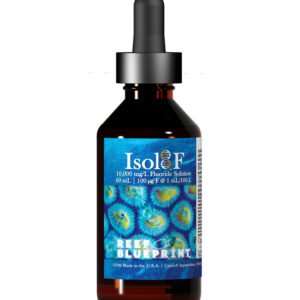Photoautotrophs, including endosymbiotic eukaryotes, utilize specific minor and trace elements during the course of various cellular functions, including, but not limited to: cell division; nitrogen uptake (nitrogen assimilation, nitrate reduction); CO2 fixation; phosphorus acquisition; photosynthesis; production of pigments and vitamins; DNA transcription. The rate of phototroph-driven element depletion within a recirculating system is mediated by photoperiod length and rate of nutrient input, among other chemical and physical factors. Failure to maintain adequate availability of these critical elements suppresses the rate of nutrient uptake, feasibly resulting in nutrient accumulation within the system and, potentially, cell death within the photoautotroph population. Many complex reactions taking place within plant and algal cells require the presence of multiple elements to achieve completion. Absence of any one of the critical elements therefore inhibits productivity.
Elements provided by this formulation: have been long-established by researchers as being critical to photosynthesis; are present in appropriate ratios; dosed as directed, will not cause suppression of photoautotroph cellular production as a result of accumulation. This formulation does not propose to act as a complete growth medium for diatom cultures, and therefore omits silicon as a component.
Supplementation of minor and/or trace elements known to suppress the growth of photoautotrophs is contraindicated in systems housing cohorts partially- or wholly-reliant upon nutrient production by endosymbiotic eukaryotes for long-term existence. Evidence suggests that presence of Lanthanides, in addition to specific heavy metals (e.g. Hg, Pb, As, Cd, Cr), inhibits growth of photoautotroph cultures. These elements are omitted from this formulation.
Keep out of reach of children and unauthorized persons. Avoid contact with skin, eyes, and mucous membranes. Store in a cool, dry location away from sunlight.
The rate of ion depletion due to photoautotroph uptake is driven by various chemical and physical factors which are unique to each independently-operating recirculating system, and which are constantly changing as photoautotroph biomass increases and decreases.
Monitoring (daily) the system’s concentrations of elements provided by this formulation, as well as the concentration of nitrate, and referencing apparent changes in coloration of zooxanthellate cnidarians will enable User to adjust dosing of this formula to suit system requirements, improving overall effectiveness and resulting in less wasted solution.
Users unable to perform analyses for elements provided by this formula are recommended to monitor nitrate concentration and apparent changes in coloration of zooxanthellate cnidarians, adjusting dosage to suit system requirements. This visual approach to dosing is fastest, and for many systems will be adequate.
Recommended is diluting an appropriate volume of this solution into a larger volume of purified water (with a purity of at least 98%), and applying this diluted solution to the system with an automated dosing system throughout the photoperiod. Dosing frequency is directly proportional to stability of ionic concentrations and, resultantly, gradual changes in the coloration (manifesting as intensification) of coloration of zooxanthellate cnidarians. A 1 – 10 s drip interval during the photoperiod provides adequate ionic stability, and is recommended.
If no automated dosing system is available, then apply solution manually each day. Dosing frequency is directly proportional to stability of ionic concentrations and, resultantly, consistent changes in coloration of zooxanthellate cnidarians. Dosage volume per 24 h is divided by the dosing frequency.
It is not recommended that this formulation be dosed fewer than four times weekly.
Because changes in coloration of zooxanthellate cnidarian tissues occur gradually, and in a non-uniform fashion among mixed cohorts, it is strongly recommended that a select number of individual cohort members be identified as subjects, recording changes in coloration with high-resolution photographs taken immediately prior to initial dosing, and at regular intervals once dosing has commenced. Physical conditions (e.g. light, water temperature, water flow) should be as uniform as possible when taking photographs. Changes in coloration are qualitative, and two observers may draw different conclusions when viewing the same specimen. Users should anticipate that noticeable changes in coloration of zooxanthellate cnidarians may require up to 5 applications of Isol8 MT to occur. Metered application, in which Isol8 MT is applied daily over the course of the photoperiod, has been observed to produce consistent results.
A quantitative impact that the application of Isol8 MT may produce in some recirculating systems is the gradual reduction of aqueous nitrate. This is discussed more fully below. The depletion of nitrate below the amount required for continued photosynthesis must be avoided in recirculating systems housing cohorts which include photoautotrophs. Nitrate supplementation may eventually be necessitated, depending upon cohort requirements.
Reference Standards: 1 mL per 250 gal. (946.25 L). If using glass dropper supplied with 60-mL package, then 1 mL is equivalent to approximately 20 drops. 1 drop per 12.5 gal. (47.3125 L). For laboratory applications, dilute 1 mL Isol8 MT into 99 mL of distilled or deionized water, and apply at 1 mL per 2.5 gal as necessary.
Initial application: Dose equivalent of 1 mL per 500 gal. (1892.5 L) every 24 h, applied during photoperiod, for initial ten (10) days.
Monitor nitrate concentration at beginning, middle, and end of photoperiod. A decrease in peak nitrate concentration recorded at the same reference times indicates increased nitrate uptake and depletion of the elements provided by this formulation. Anticipate noticeable changes in coloration of zooxanthellate cnidarians during the latter half of this initial dosing period. Diverging from this initial dosing regimen is discouraged.
Maintenance application: Decrease dosage to 1 mL per 1,000 gal. (3,785 L) every 24 h, applied during photoperiod. Equivalent is 1 drop per 50 gal. (189.25 L) per 24 h when applying with 60-mL package dropper. Do not exceed 1 mL per 250 gal. (946.25 L) per 24 h.
Apply 1 mL per 250 gal. (946.25 L) new water added to recirculating systems during routine water changes.






